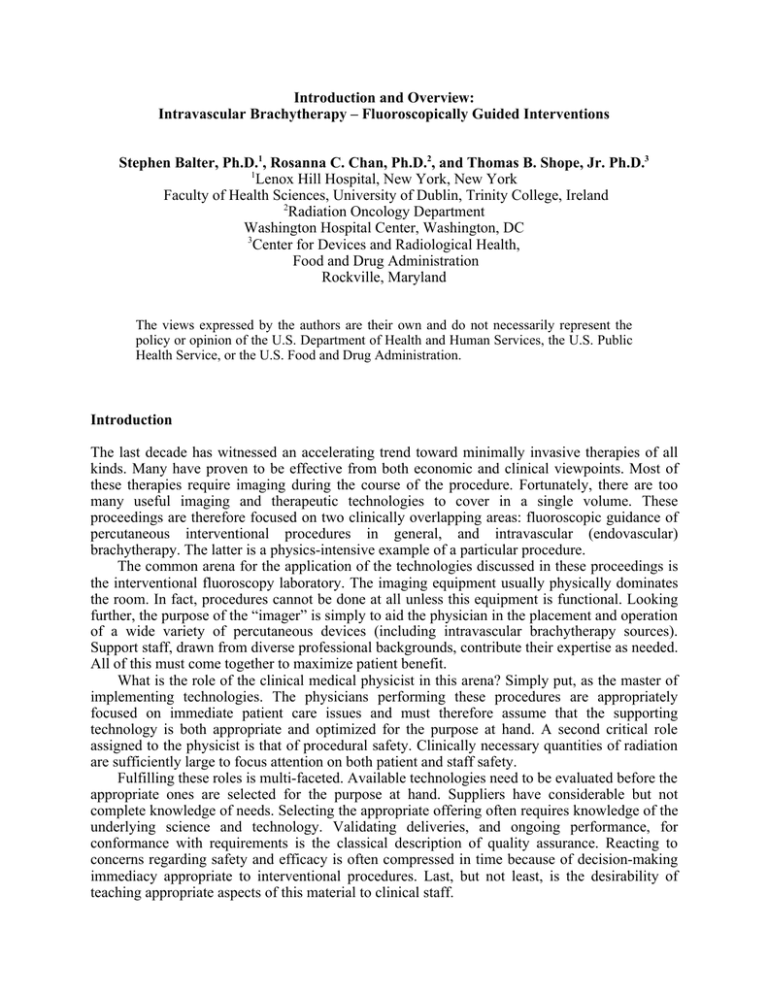Introduction and Overview: Intravascular Brachytherapy – Fluoroscopically Guided Interventions Stephen Balter, Ph.D.
advertisement

Introduction and Overview: Intravascular Brachytherapy – Fluoroscopically Guided Interventions Stephen Balter, Ph.D.1, Rosanna C. Chan, Ph.D.2, and Thomas B. Shope, Jr. Ph.D.3 1 Lenox Hill Hospital, New York, New York Faculty of Health Sciences, University of Dublin, Trinity College, Ireland 2 Radiation Oncology Department Washington Hospital Center, Washington, DC 3 Center for Devices and Radiological Health, Food and Drug Administration Rockville, Maryland The views expressed by the authors are their own and do not necessarily represent the policy or opinion of the U.S. Department of Health and Human Services, the U.S. Public Health Service, or the U.S. Food and Drug Administration. Introduction The last decade has witnessed an accelerating trend toward minimally invasive therapies of all kinds. Many have proven to be effective from both economic and clinical viewpoints. Most of these therapies require imaging during the course of the procedure. Fortunately, there are too many useful imaging and therapeutic technologies to cover in a single volume. These proceedings are therefore focused on two clinically overlapping areas: fluoroscopic guidance of percutaneous interventional procedures in general, and intravascular (endovascular) brachytherapy. The latter is a physics-intensive example of a particular procedure. The common arena for the application of the technologies discussed in these proceedings is the interventional fluoroscopy laboratory. The imaging equipment usually physically dominates the room. In fact, procedures cannot be done at all unless this equipment is functional. Looking further, the purpose of the “imager” is simply to aid the physician in the placement and operation of a wide variety of percutaneous devices (including intravascular brachytherapy sources). Support staff, drawn from diverse professional backgrounds, contribute their expertise as needed. All of this must come together to maximize patient benefit. What is the role of the clinical medical physicist in this arena? Simply put, as the master of implementing technologies. The physicians performing these procedures are appropriately focused on immediate patient care issues and must therefore assume that the supporting technology is both appropriate and optimized for the purpose at hand. A second critical role assigned to the physicist is that of procedural safety. Clinically necessary quantities of radiation are sufficiently large to focus attention on both patient and staff safety. Fulfilling these roles is multi-faceted. Available technologies need to be evaluated before the appropriate ones are selected for the purpose at hand. Suppliers have considerable but not complete knowledge of needs. Selecting the appropriate offering often requires knowledge of the underlying science and technology. Validating deliveries, and ongoing performance, for conformance with requirements is the classical description of quality assurance. Reacting to concerns regarding safety and efficacy is often compressed in time because of decision-making immediacy appropriate to interventional procedures. Last, but not least, is the desirability of teaching appropriate aspects of this material to clinical staff. Understanding is bidirectional. Physicists need to have a reasonable understanding of the clinical basis of procedures and alternatives available to the patients. This is an important part of understanding the benefit/risk decisions taken as part of patient management. Also, on a practical level, the physicist enters a possibly unfamiliar physical environment staffed by professionals with different priorities and understandings. Teaching to, and learning from, these individuals should be considered a never-ending educational opportunity. The AAPM summer school for which these proceedings are written is divided into two tracks. The “diagnostic” track focuses on interventional fluoroscopy. The “therapeutic” track focuses on vascular brachytherapy. The profession of medical physics has evolved from mainly generalists who had reasonable knowledge of many areas to specialists in fewer areas. Our arena stresses a requirement for physicists to have enough overall knowledge to see the big picture. Thus, there are a substantial number of “joint” sessions covering topics of general interest. Track jumping, either during the summer school itself or by readers of this volume, is encouraged to gain further insights. Topics Related to Both Intravascular Brachytherapy and Interventional Radiology (Joint Sessions) Radiobiology The clinical management of patients with peripheral and coronary artery diseases has improved dramatically over the last 20 years due to innovative interventional techniques. Real-time visualization of vascular abnormalities has made diagnosis and immediate treatment of vascular abnormalities a reality. However, patient overexposures have been documented and interventional workers have been exposed. Recently, ionizing radiation has also been used in interventional laboratories for the treatment of the aggressive wound healing seen after balloon angioplasty and arterial stent implantation. Because of the ever-increasing number of fluoroscopy-based procedures and the use of radionuclides for diagnosis and treatment, the radiobiology of interventional radiology and interventional cardiology has become an important subset of radiation biology. Quantitative Angiography And Interventional Ultrasound The interventional laboratory is a bastion of visual metrology. It is common to observe an interventionalist perform a test injection and then decide that the appropriate treatment is a 3.25 (mm when expanded) stent delivered over a 0.018 (diameter in inches) guidewire through a 7 French (3.14 French = 1 mm outer diameter; 7Fr = 2.23 mm OD) guiding catheter. This decision is made, with reasonable accuracy, with unknown and somewhat variable geometric magnification. The known sizes of the guiding and diagnostic catheters provide the scale that allows this to be done with reasonable accuracy. Accuracy and precision can be improved by means of quantitative angiography. Families of tools exist to analyze the contrast column in a vessel and quantitate its morphology. Modern systems are capable of doing this with minimal human intervention. Measurements can be made at tableside in the interventional laboratory or at a later time. The data are used both as input into therapeutic decision-making and for quantitative follow-up of procedural outcomes. Angiographic techniques are by definition limited to analysis of the contrast-filled lumen of a vessel. Intravascular ultrasound (IVUS) provides means for seeing and quantitating beyond the lumen wall. A catheter containing an ultrasound transducer is placed in the vessel of interest. This produces a cross-sectional image extending several millimeters from the transducer. A controlled pull-back yields a three-dimensional view of the vessel. These images allow the interventionalist to characterize anatomical structures and the location of implanted devices such as stents. One use is for vascular brachytherapy: Three-dimensional information should allow better delineation of radiotherapeutic targets and critical structures. Appropriate use of this information should contribute to better treatment planning and delivery. Interventional Cardiology Annually, there have been more than a half-million coronary angioplasties performed in the United States. These procedures have proven to be beneficial to patients. In many cases, a successful angioplasty eliminates the need for open-heart surgery. However, in 15% to 35% of patients, restenosis occurs within 6 to 9 months after the procedure. Vascular brachytherapy is a technology that reduces the restenosis rate. Brachytherapy is now used for the treatment of coronary in-stent restenosis. Food and Drug Administration (FDA) approval for treatment of in-stent restenosis in coronary arteries was granted based on multiple clinical trials. Both gamma- and beta-emitting treatment systems show efficacy and safety. Other indications such as treatment of de novo lesions and peripheral arteries are awaiting further supportive data from ongoing clinical trials. Questions remain regarding the utility of vascular brachytherapy and disseminating it as a tool to prevent restenosis. Potential complications, such as late thrombosis, edge effect, late restenosis, and aneurysm formation as well as the logistic issues associated with the use of this technology in the catheterization lab environment, are delaying the acceptance in routine use. Staff Radiation Safety The goal of any safety program is that of facilitating useful activities while simultaneously reducing the participants’ risks to an acceptable level. Achieving this goal requires a balance between the value of the activity and the associated risks. In many cases, reducing one risk increases another. Achieving a balance between various risks and the benefits of the activity is “relatively” simple when the risks and benefits are all attributable to the same individual. The balance is much more difficult when one person assumes the risks and another person collects the benefits. Interventional staff are exposed to many risks for the benefit of their patients. Stochastic radiation injury is only one of these. Medical physicists contribute to staff safety by analyzing and balancing risks as well as by performing the ‘usual’ duties involved in radiation safety. Educating interventional staff makes an important contribution to this process. The value of these contributions can be maximized only when the physicist understands factors such as staffing patterns and procedural requirements. For example, the conventional radiation safety triad of principles is distance, time, and shielding. Two additional principles applicable in the interventional lab are beam management and situational awareness. These latter factors enter because of the necessity of staff presence at tableside while radiation is being produced. Interventional Radiology Most individuals, if asked to describe what radiologists do, may say that they sit and look at images. Most diagnostic radiologists do exactly this, providing diagnoses on the basis of images they interpret. These radiologists have relatively little direct involvement with patients. Interventional radiology, however, is quite different. They have a much more active and direct role in patient care. Interventional radiology procedures may be categorized broadly as diagnostic procedures, non-vascular interventions, and vascular interventions. Interventional radiologists work on virtually every organ system in the body. Interventional radiologists practice a radiologic subspecialty in which imaging guidance is used to direct various devices for the invasive diagnosis and treatment of disease. The imaging modality may be fluoroscopy, computed tomography (CT), CT fluoroscopy, ultrasound, or magnetic resonance imaging (MRI). This definition is extremely broad because it must encompass a wide variety of procedures. Interventional radiology procedures are typically performed through a 3–5 mm skin incision. These minimally invasive procedures have largely replaced those open surgical procedures which accomplished the same therapeutic objectives because minimally invasive procedures offer so many advantages: lower morbidity and mortality, less post-procedure pain, faster recovery and shorter hospitalizations, sometimes greater effectiveness, and often lower cost. Unfortunately, some of these procedures occasionally entail radiation doses sufficient to produce skin injury. Percutaneous procedures are preferred by patients because of the small incision and the faster return to normal activity as compared to conventional surgery. The same trend has been evident in general surgery for some years, as laparoscopic cholecystectomy has replaced open cholecystectomy and laparoscopic nephrectomy is replacing open nephrectomy. Radiation-Induced Skin Injuries There are many procedures that employ imaging to guide an intervention. For example, drainage of a cyst is an intervention that may be done under fluoroscopic, ultrasound, or CT control. Some procedures have the potential to deliver doses that represent a substantial risk for stochastic or deterministic effects. The types of procedures most likely to deliver such doses are complex fluoroscopically guided interventions. These include: abdominal, pelvic, or cerebral embolizations; transjugular intrahepatic portosystemic shunt (TIPS) placement; electrophysiological ablation; coronary angioplasty; and endovascular therapy (stent placement). Skin dose levels in complex interventional fluoroscopy procedures are similar to prescription and critical tissue doses in vascular brachytherapy. Thus, fluoroscopic skin injuries give some insight to vascular tissue reactions. Similarly, lower restenosis rates from radiation treatment in special vascular brachytherapy populations (e.g., diabetes) might give insights as to the susceptibility of these types of patients to fluoroscopic skin injury. Radiation management is a clinical decision. Patients undergoing interventional procedures have a serious medical condition that needs to be treated. The risk of a stochastic injury or the certainty of a deterministic event are elements of patient care that need to be considered. Stochastic risk can be considered in general terms. The age distribution of the interventional patient population, and the nature of the underlying medical conditions may lead to a decision that stochastic risk is of lesser concern. With regard to deterministic injury, the operating physician needs knowledge of the consequences of different radiation levels to appropriately balance the benefits and risks of specific procedures with regard to individual patients. Federal And State Regulations Public health is a broad subject; many decisions have to be made to determine appropriate actions. There are a multitude of risks that affect a given population. Good government considers which are the most serious risks and acknowledges the scientific uncertainty in assessing risk. Good government also considers which risks are amenable to control. People do not make decisions based solely on risk. Any situation presents a complex mixture of risks, cumulative impacts, synergism, and diverse populations. Regulations are based on a complex balance of minimizing actual risk, minimizing perceived risk, and with consideration of the public’s acceptance of risk. The ability to regulate effectively or, more importantly, to address public health needs depends on a nominal agreement that there is value in diminishing the risk to the population impacted. This requires a great deal of communication and cooperation. In the old days, life was simple. Government regulated and the regulated community obeyed. It was a “command and control” relationship. These days, regulatory changes begin with a dialogue. When should we regulate? Why should we regulate? How should we regulate? Who should we regulate? We have entered a stage in government where the necessity of regulation is balanced against the cost of compliance. The process of regulating is a cooperative venture. The appropriate levels of government are involved, with federal, state, county, and local government all participating within their authority. There are major factors to consider beyond traditional radiation safety regulations. The procedures performed in the interventional radiology laboratory depend on a growing and everevolving variety of medical devices of increasing sophistication. Whether the staff of a laboratory is involved in research and/or clinical trials or simply in the delivery of clinical care and management of patients, it is important for the physicians and physicists involved to know about the regulatory structure affecting the availability of new devices and, through these devices, the practice of interventional radiology. This is especially important if they anticipate becoming involved in such research, want to participate in clinical trials, or simply want to understand the regulatory programs that impact the availability of new products or impact the practice of interventional radiology. Intravascular Brachytherapy Sessions The FDA’s approval for vascular brachytherapy (VBT) [or intravascular brachytherapy (IVBT)] in November 2000 marked the major breakthrough from a decade of dedication in research and commitment to the fight against restenosis and helped to establish the role of radiation therapy in the Cath Lab. IVBT first emerged from the need to resolve the issue of restenosis that presented itself as a side effect of angioplasty. It was through the insights of individual investigators that the industry was stimulated to find innovative ways to address this problem. As development of the new technique progresses, a different sector in the field of brachytherapy began to surface. To overcome issues related to source design, production, radiation biology, near-field dosimetry, and dose optimization, experts from different specialties joined forces. It was through these collaborative efforts that we gained a better understanding of IVBT and learned how to overcome some of its limitations, which led to the confirmation of its useful role for the treatment of in-stent restenosis. While the technique is still a work in progress, there are issues, as stated by Waksman, that need to be addressed. As IVBT is being disseminated to the hundreds of catheterization laboratories around the world, it is pertinent that the fundamental concepts be fully appreciated so that this technology can continue to grow. The goal of this session is to bring physicists who are new to this area up to speed with the latest findings and technologies, and to provide tools for them should there be a decision to implement an IVBT program in their institutions. Radioisotope Production Most radioisotopes used for medical application are so readily available that it is transparent to end users the difficulties encountered during production. In recent years, there has been the fear of possible shortages due to the limited resources available for production. Early on in the development of IVBT, researchers combed through the periodic chart to find the “ideal” source that would meet all the criteria for an IVBT source, such as safety, decay time, size, etc. A lot of the “potential” candidates did not make it, in part due to limitations encountered in production. This chapter presents an overview of the special considerations and limiting factors relevant to the production of IVBT sources. It reviews the basic principles of nuclear reactors and the modes of production available for various medical isotopes. It provides readers with a greater appreciation of the considerations involved in production of the product. Selection Of Radionuclides During early animal studies, choice of radioactive isotope was limited to availability. Due to the intricacy of the PTCA procedure and the location of the treatment area, an ideal source would be one that is small in size, high in activity, long half life, readily available, safe to handle in the cardiac cath lab and inexpensive to produce. Early development centered on existing brachytherapy sources, such as 192Ir seed and radioisotopes such as 32P and 90Sr/Y. The goal was to design an IVBT source that would deliver a uniform dose of radiation to the arterial wall. From geometric considerations alone the delivery of uniform dose is basically impossible. The best dose distributions (i.e., the least inhomogeneous) would be achieved either with intermediate energy gamma or X-ray sources (30 to 100 keV), or high-energy beta sources (>2 to 3 MeV). However, at these energy ranges no readily available isotopes with suitable half-life and high specific activities exist. More than a dozen alternate isotopes have been evaluated for IVBT, as have radioactive liquid, gas, and coated balloons for delivery systems. So far only three isotopes that marginally meet the desired criteria have found widespread use as catheter-based seed or wire IVB sources: 32P, 90Sr/Y, and 192Ir. Dose fall-off in water versus radial distance for these sources, under ideal geometries, are approximately 35%/mm for 192Ir, 55%/mm for 90Sr/Y, and 70%/mm for 32P. Dosimetric Issues In Vascular Brachytherapy The TG-43 formalism introduced in 1995 as an AAPM report was originally developed for photon-emitting sources used for interstitial brachytherapy. Though not actual point sources, these radioactive sources are generally very small as compared to the tumor sites being treated and the depth of penetration needed beyond the range of beta emitters. Thus, no provision was made in early development for near-field dosimetry of these sources. With IVBT, where the target volume is similar in size to the source, these relatively similar sizes pose serious challenges for accurate dose description for the volume of interest. In addition, TG-43 formalism is not applicable to beta line sources, which are longer than the beta-particle range. Various methods used for near-field dosimetry data measurements are presented in this chapter, together with the available data and the author’s critiques of the dosimetry methods. Although some of these results have been incorporated into the TG-43/TG-60 formalisms, problems involved with these measurements are still far from being totally resolved and more work is underway. Monte Carlo Modeling For Intravascular Brachytherapy Sources In recent years the use of Monte Carlo modeling to overcome some of the challenges encountered in phantom measurement has become increasingly popular and is being recognized by the medical physics community as a valuable adjunct to measurements. With IVBT, where experimental dosimetry characterization is extremely difficult, Monte Carlo modeling would be a logical approach. However, there are numerous versions of general-purpose modeling code available for IVBT. To facilitate better understanding in data comparison, a history of Monte Carlo modeling is first presented, followed by comparing the results generated using the different codes. Over the range of depths of interest in IVBT, general agreement among the major codes is achievable to within 3% to 10% for the more difficult case of beta emitters. Agreement with measurements, however, can be within 10% to 30% for these codes. Moreover, care should be taken in understanding the algorithms and cross sections used by the code(s) and in choosing the proper parameters for a particular calculation. The author also cautions us that the source term used in calculations is usually based on the assumption of simple uniformity, so small differences from the real world can be expected. When inhomogeneous media is involved, differences as large as 10% to 15% can be expected at radial distances of a few millimeters and these differences increase at larger distances. In addition, point-kernel methods that are 2 to 3 orders of magnitude faster in calculation speed can be a valuable adjunct to Monte Carlo Modeling. Source Standardization and Calibration for Intravascular Brachytherapy Like all radiation therapy treatments, efficacy of IVBT depends largely on the accuracy of the dose delivered. Use of short half-life isotopes results in frequent source changes that necessitate a well-defined calibration quantity for source validation. There is general agreement that for IVBT sources, air kerma strength is used for gamma emitters and absorbed dose to water at 2 mm from source center for beta sources. Primary standards for all these sources are from the National Institute of Standards and Technology (NIST) and then are transferred to the clinic via an Accredited Dosimetry Calibration Laboratory (ADCL). The fact that the reference point is at the high dose gradient region causes greater uncertainties in the calibration. Also the type of emission and the energy will affect the calibration methodology. Various methods used by NIST and the ADCLs for this are presented in this chapter. Recently the Nuclear Regulatory Commission (NRC) issued a guidance document that required a commitment by the medical physicist to make an independent measurement of source output before putting the source into clinical use. As the number of clinical sites increases, it is pertinent that the end users take great care to ensure consistency among institutions so that data collected can be beneficial for future advancement of the technology. Operational Considerations In IVBT The success of an IVBT program relies heavily on the collaboration between both the Cardiology and the Radiation Oncology groups. To establish a good program, one needs to have a good understanding of the overall procedures and the role of the different key players. One of the biggest challenges is scheduling. Logistics for setting up an IVBT program are presented in this chapter together with an overview of licensing, the quality assurance program, and a description of the operating procedures for all the commercially available sources. The objective is to establish a guideline for medical physicists who may be involved in the implementation of this technology. Radiation Protection For IVBT This chapter addresses IVBT radiation safety considerations. Radiation safety is always a big concern for brachytherapy facilities. The fact that IVBT is to be performed in the Cath Lab, especially with gamma sources, heightens the anxiety. Prior to implementation of the program, a radiation safety evaluation of the area around the labs must be performed. Provisions for the type of radioactive sources and systems to be used must be made. The number of cases per week, architectural design of the room and its surrounding area, storage area for radioactive sources, emergency plan, and patient and staff education have to be take into account. Pre- and postprocedure patient surveys are a must and it is always advantageous to have policy and procedures implemented before starting the program. Intravascular Brachytherapy Treatment Planning Treatment planning for IVBT is far from the sophistication seen in other radiation treatments. Planning time is often limited by the clinical situation. However, the therapeutic window may be wide enough to minimize the need for dose optimization. For most IVBT treatment, dosimetry is based on point dose calculations. Intravascular ultrasound (IVUS) imaging for treatment planning is only specified for one IVBT system. In many cases IVUS is limited to data analysis and research. The latter includes the use of dose volume histograms generated from IVUS-based planning to evaluate the effect of source centering, curvature, and presence of guide wires and metallic stents on the resulting dose distribution. As technology evolves giving us a better understanding of the target area and handling of imaging data, more instantaneous, real-time treatment planning for IVBT will become feasible. Quality Assurance For IVBT The primary goal of all quality management (QM) programs in radiotherapy is to assure safe delivery of the correct dose to the correct site. The basic concept is, whenever possible, to verify all the important parameters using a second independent method. Guidelines for establishing a comprehensive QM program for IVBT using the transcatheter approach are presented. It is also suggested that the QM program for IVBT should be an integral part of the overall departmental QM program and the requirements of the International Standards Organization standard ISO 9001-2000 regarding QM could serve as a guide in the establishment of such a program. Professional Relationships In VBT Since the introduction of vascular brachytherapy (VBT), the AAPM has been involved in efforts to establish the roles of the various professionals who are involved in the procedure. During this process, the AAPM has been in contact with professional societies representing cardiologists, interventional radiologists, radiation oncologists, and medical physicists. Through these collaborations, two documents have emerged that have attempted to define the roles of professionals involved in VBT. The latest document, entitled “Proposed Joint Publication on Coronary Artery Radiation Therapy (CART)/Vascular Brachytherapy (VBT),” was authored jointly by the American Society for Therapeutic Radiology and Oncology (ASTRO), the American College of Cardiology (ACC), the Society for Cardiac Angiography and Interventions (SCAI) and the AAPM. The document addresses the roles of the involved professionals at each of the steps required to develop and conduct a program of intravascular brachytherapy. It explicitly addresses issues of radiation safety, treatment planning, treatment time calculation, and quality assurance. The role of the medical physicist is identified clearly. It is hoped that this document will eventually receive review and endorsement of the contributing societies. Fluoroscopically Guided Intervention Sessions A Tour of the Interventional Laboratory The many problems or pathologies that can exist in the complex system that is the human vascular system require many types of special equipment to identify, treat, and assess the results of diagnosis and treatment. The interventional radiology laboratory provides much of this capability to successfully address an increasing variety of these conditions. The laboratory typically contains an assortment of items, including the fluoroscopic x-ray system, all of which can have a critical role in the success of the procedure and the safety of the patient and laboratory staff. The “Tour of the Interventional Vascular Imaging Suite” will provide a familiarization with the variety of equipment found there to accomplish the clinical tasks. This equipment includes not only the fluoroscopic x-ray system but also the variety of devices and auxiliary equipment required for the procedures performed. A full understanding of the modes of operation and features of the x-ray equipment is essential for accomplishing the clinical goals while providing the maximum protection for staff and minimizing radiation exposure or other adverse effects to the patient. Design of an optimally configured laboratory requires a thorough understanding of the clinical imaging requirements and the procedures performed, the imaging equipment features, options and operational modes, and the auxiliary and protective equipment needed to support the procedures. Fluoroscopic Image Receptors A critical component of the fluoroscopic x-ray systems used in interventional radiology is the fluoroscopic image receptor and the means used to determine the X-ray intensity distribution that represents the fluoroscopic image. The x-ray image intensifier tube, coupled to a video camera or, more recently, a charge-coupled device, is a mature technology for capturing fluoroscopic images. Recently, flat panel array technology has been developed for radiographic imaging and is beginning to be available for fluoroscopy and the digital equivalent of cinefluorography. Medical physicists will need to become increasingly more familiar with these large area integrated circuits called active matrix arrays that are being coupled with traditional X-ray detection materials such as phosphors and photoconductors to form flat panel x-ray imagers. As this technology develops, medical physicists will need to understand its designs and methods to describe and evaluate its performance. It is anticipated that this technology will be developed to perform as fluoroscopic image receptors at a reduced dose due to their anticipated improved detective quantum efficiency. However, several problems remain to be solved. These are the need to reduce their noise levels at the low exposure rates for fluoroscopy and to reduce image lag following large radiographic exposures. The review of the physics and technology of fluoroscopic image receptors will provide an introduction to the performance of these key components of a fluoroscopic x-ray system. Image Presentation Processing and Display Systems for Interventional Radiology This chapter describes the need for and the progress toward a standards-based strategy or approach to the communication and processing for presentation of digital images from the interventional and cardiology laboratories. The filmless environment using picture archiving and communication systems, Internet browsers for access to images, and image presentation (display) on a wide spectrum of display systems requires (or demands) that radiology and cardiology images be prepared and communicated under standards and protocols that facilitate automatic presentation with consistent and predictable image quality. A strategy is described that separates the stages of image processing into acquisitionspecific, application-specific, and presentation-device-specific stages. The way in which the Digital Imaging and Communications in Medicine (DICOM) standard supports this strategy is discussed. The strategy suggests that the capability is needed to display images on any display device in a manner such that the images match or correspond to the appearance they would have on a reference display device or under reference display conditions. The limitations of the current DICOM standard with regard to communicating information about the spatial or temporal modulation transfer characteristics of the reference display device or the conditions under which the image was obtained, which are needed for full implementation of the strategy, are noted. The image-quality performance of high performance cathode ray tubes and liquid crystal display systems are described. This is followed by a description of the image-presentationrelated components of the DICOM standard and discussion of how they are used to facilitate standard grayscale presentations between different display systems. The chapter concludes with a discussion of the presentation-related processing functions appropriate to the image acquisition system and to the workstation associated with the display system. Picture Archiving and Communication Systems for Interventional Radiology The advantages and capabilities presented by digital fluoroscopic systems have been recognized in interventional radiology and cardiology. These include the elimination of film processing, immediate availability of images for review, and the ability to access and display images at multiple, dispersed locations. With these advantages come the challenges associated with acquisition, storage, and transmission of the very large amounts of digital data, which for a moderately used system can reach to the tens of gigabytes of data per day. Along with the development of the capabilities of the digital imaging systems has come the need to develop standards for the exchange of data among systems of different manufacturers and to different display devices and the development of systems and networks to manage the storage, distribution, and display of images and associated information efficiently. A key development that has facilitated the efficient distribution and storage of digital images has been the development of effective techniques for image compression. Following a description of the typical volumes of digital image data generated in interventional radiology and cardiology laboratories and the image management systems that support storage and distribution of these images, this chapter provides an overview and discussion of the various image compression methods that can be applied to digital images. The results of studies are cited that indicate that for the commonly used JPEG method of lossy compression some degradation of observer performance using compressed images begins to occur at compression ratios of 10 to 1. Methods For Skin Dose Determination As fluoroscopically guided interventional procedures have become more complex, resulting in long fluoroscopic exposure times and, rarely, serious, radiation-induced skin injuries, the necessity for physicians performing these procedures to have information related to patient dose has become widely acknowledged. The need for immediate feedback regarding patient dose during the procedure has been recognized. A requirement for display of dose-related information was recently incorporated into a new international standard for interventional x-ray systems and a similar requirement is under consideration for inclusion in the mandatory Federal equipment standard in the United States. These requirements will impact equipment installed in the future. There is also a need for effective and easily implemented methods for monitoring patient dose that can be used with existing fluoroscopic equipment. This chapter reviews the methods that have been used for patient dose measurement or monitoring, emphasizes the necessity for methods that provide information regarding the actual dose distribution on the skin of the patient to truly understand the potential for radiation injury, and describes means to determine the maximum skin doses and their locations on the skin during a procedure. It is emphasized that radiation dose management must be one of the aspects of risk management during the procedure and that real-time measurements of patient dose during complex procedures provides input to the ongoing benefit/risk analysis that must be conducted throughout the course of the procedure. Pediatric Interventional Radiology Fluoroscopic imaging of pediatric patients in the interventional radiology or cardiology laboratory presents special challenges for obtaining images with appropriate image quality and without excessive radiation dose. Unless special precautions are taken to address the unique needs associated with the imaging requirements presented by children and the range of patient sizes, from neonates to adults, excessive radiation dose may result. A large range of technique factors, appropriately used, is required. The smaller size of the anatomy to be imaged, the greater rate of cardiac motion, the smaller interventional devices to be visualized, and the reduced amounts of contrast material tolerated all place increased demands for careful imaging system operation and require special care in the setup and use of the fluoroscopic system. This chapter describes the range of system variables and characteristics appropriate for pediatric imaging and provides guidance on the system parameters and features necessary to ensure adequate images and to minimize patient exposure. Appropriate automatic exposure control design and operation is essential for system operation in a manner that limits unnecessary patient exposure. Purchasing Fluoroscopic Equipment The interventional fluoroscopic x-ray equipment acquisition process, in its broadest context, provides the medical physicist with a series of challenges and opportunities to make a significant contribution to his or her institution. As part of a comprehensive quality improvement program in an institution, the quality improvement program for interventional imaging equipment has as its goal the achievement of image quality that meets the clinical goals at the lowest radiation dose to the patient and staff. Such a program must begin prior to the acquisition of the x-ray equipment and continue throughout its use. As described in this chapter, this process involves: (a) identification of clinical requirements for the imaging equipment, (b) justification of the project, (c) equipment acquisition planning and conduct of the purchasing process, (d) facility planning to accommodate the equipment and ancillary items, (e) acceptance testing, (f) staff education regarding the equipment, (g) routine performance testing, (h) equipment maintenance and repair, and (i) appropriate recording keeping. Each aspect of this process is described in detail in this chapter and suggestions are offered on minimum equipment specifications. Quality Improvement Programs In Interventional Radiology A key role or function of the medical physicist in healthcare facilities is the responsibility they typically bear for operation and oversight of those parts of the facility’s quality improvement program that relate to the diagnostic imaging equipment of the facility, including fluoroscopic xray systems. Such programs are implemented because the facility desires to provide the highest quality and safest services possible and because certain activities that can be components of quality improvement programs are required by accrediting bodies or are mandated by regulation. For diagnostic imaging systems these activities include acceptance testing of the imaging system prior to the first use and periodic quality control testing or performance monitoring during the useful life of the equipment. The first of these, acceptance testing, involves extensive testing and evaluation of all aspects of the equipment performance to ensure that purchase specifications are met, that installation and initial adjustments have been performed correctly, and to establish baseline performance measures for comparison to later quality control or performance monitoring results. The periodic quality control or performance monitoring measurements are typically a subset of the tests performed during acceptance testing and are intended to identify and facilitate correction of degraded performance. This chapter provides a discussion of the tests and evaluations that should be included in a comprehensive acceptance test for an interventional xray system. Suggestions are also provided regarding the tests that should be considered as part of the periodic performance monitoring or quality control program. Throughout the discussion, values of test results typical of properly functioning systems are suggested. Accreditation, Benchmarking, and Troubleshooting in Interventional Radiology As healthcare facilities endeavor to establish programs and services that identify their organization as a facility providing the best or highest levels of service and patient care in an increasingly competitive environment, there is growing interest in accreditation programs. These are programs through which their expertise, capabilities, and high level of service can be validated. A minimum level of competency has for a long time been evidenced through accreditation by the Joint Commission on the Accreditation of Healthcare Organizations (JCAHO). However, as facilities and medical professional organizations recognize that more specific evaluation and benchmarking have value in assuring an improved or high level of patient care and demonstrating the same to potential patients and other stakeholders, a number of professional organizations have developed or are developing accreditation programs for specific medical services. Several of these programs are aimed at the interventional radiology or cardiology laboratories. Specifically, the American College of Radiology (ACR) is developing an accreditation program for vascular interventional laboratories and the Society of Cardiac Angiography and Interventions (SCAI) has recently reestablished a Cath Lab benchmarking project. Both these programs will utilize specially developed phantoms to characterize the imaging performance and radiation dose delivered by interventional facilities for comparison with minimum standards or norms of performance. This chapter describes these accreditation programs, the measurement phantoms developed to support each program, and the recent efforts by the Society of Interventional Radiology, formerly the Society of Cardiovascular and Interventional Radiology, to establish data on the range of patient doses resulting from a wide variety of interventional procedures. In addition, the chapter concludes with a discussion of typical performance problems that can occur for interventional x-ray systems. Potential causes are suggested that can be considered in troubleshooting these performance problems that may be uncovered by such performance assessments or during routine testing. Radiation Safety Training For Interventional Staff Recent reports of serious radiation-induced injuries from interventional procedures and consideration of the causes for such injuries have highlighted the need to ensure that all physicians who use fluoroscopic x-ray systems have appropriate training in radiation safety and management of radiation. There have recently been a number of discussions and proposals that focus on the manner in which such training and knowledge could be assured for all users of fluoroscopic systems. This chapter reviews these recent efforts to implement programs to assure that all physicians using fluoroscopy have adequate training to do so safely and outlines ways in which the medical physicist can encourage such activities in his/her institution. Conclusions This volume is intended to introduce the reader to a variety of key topics in the areas of interventional fluoroscopy and vascular brachytherapy. The meeting ground for these technologies is a brachytherapy treatment delivered in an interventional laboratory. The medical physics community must support technical development and the clinical deployment of both technologies. Crossover between “diagnostic” and “therapeutic” topics will provide medical physicists specializing in one area with basic information about the other. Each area is, by itself, a complex topic. The separate chapter references will guide further study.






